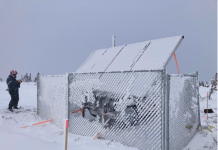A massive amount of wind data was recently made accessible online, greatly expanding the amount of information available on wind flow across the continental United States.
The data from the Energy Department’s National Renewable Energy Laboratory (NREL) enables anyone considering building a wind plant, or even erecting a single turbine, to understand how strong breezes tend to blow across a particular area and how energy from the wind can be integrated into the electrical grid.
Originally released in 2015, the Wind Integration National Dataset — also known as the WIND Toolkit—made 2 terabytes of information available, covering about 120,000 locations identified using technical and economic considerations. The newly released subset holds 50 TB, or 10 percent of the entire database, covers 4,767,552 locations, and extends 50 nautical miles offshore. Small sections of Canada and Mexico are included as well.
“The entire dataset is 500 terabytes,” said Caleb Phillips, a data scientist at NREL. “This is far and above the largest dataset we work with here at NREL.”
The data was always available, just not easily or in a simple, usable form. To make the information readily accessible, NREL used its ongoing relationships with Amazon Web Services (AWS) and The HDF Group. Having the dataset hosted on AWS will remove previous limitations on the amount of information that can be accessed readily online.

“What we’ve tried to do is make this really easy, so folks can play with the data and use it to better understand the potential for wind resources at a greater number of locations,” Phillips said. “They can download only the data they want.”
An interactive online visualization lets users interact with the data.
The HDF Group developed the Highly Scalable Data Service (HSDS) using the AWS cloud to provide users with easy access to the data, which is stored as a series of HDF5 files. The information can be narrowed to a specific site or time and analyzed using either a custom software solution or the Amazon Elastic Compute Cloud (Amazon EC2).
“We are very excited to work with both NREL and AWS to make their large, technical data sets more accessible through our new scientific data platform, HDF Cloud,” said David Pearah, CEO of The HDF Group. “Our work aims to pave the way for large repositories of scientific data to be moved to the web without compromising query performance or resources.”
The WIND Toolkit provides barometric pressure, wind speed and direction, relative humidity, temperature, and air density data from 2007 to 2013. These seven years of data provide a detailed view of the U.S. wind resource and how it varies minute to minute, month to month, and year to year. These historical trends are essential for understanding the variability and quality of wind for power production. The simulated results were computed by 3Tier under contract for NREL using the Weather Resource Forecast model.
“Now that we have a data platform that supports release of large data sets, we hope to use this capability to release other big data as well that were previously considered too large to make publicly available,” Phillips said. “We are thrilled to make these datasets available, allowing researchers to more easily find and use the data, as well as reducing costs for the national laboratory.”
Coming online next are solar irradiance data and wind data for Mexico, Canada, and potentially other countries.
While measurements across the rotor-swept areas are the best way to determine wind conditions at a site, that’s not always possible. The WIND Toolkit provides an estimate, but actual conditions can be validated using on-site measurements as required.
The first release of data prompted regular calls from people in academia, industry, and government wanting additional information. The federal Bureau of Oceanic Energy Management contracted with NREL to provide additional information for offshore areas. The WIND Toolkit Offshore Summary Dataset was made publicly available last year.
The original work to develop and release the WIND Toolkit was funded by the U.S. Department of Energy, Office of Energy Efficiency and Renewable Energy, Wind Energy Technologies Office.
Source: NREL
For more information, go to nrel.gov



























